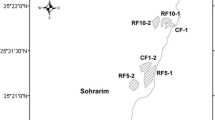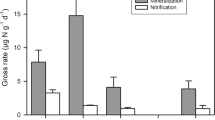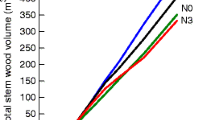Abstract
• Context
Old-growth forests with natural forest development and complex stand structure have become extremely rare in Central Europe. Changes of biogeochemistry and the N cycle across a full forest development cycle are not well understood.
• Aims
We tested the hypothesis that net N mineralization and the relative importance of nitrification are increasing with proceeding forest development from regeneration to decay stages.
• Methods
In an unmanaged old-growth spruce forest, we measured net ammonification and nitrification rate in the five forest development stages in 2 years using the intact soil core incubation method.
• Results
Net N mineralization (and ammonification) rates were higher in the closed stands of the optimum and over-mature stages than in the more open decay and regeneration stages. Only a small proportion of NH4 + was oxidized to NO3 − in the studied acidic soils.
• Conclusion
Lower N mineralization in the more open than the closed patches of this natural forest is unexpected, contrasting with the findings from artificial gaps. Possible reasons are reduced litter supply and lower canopy N interception in gaps in this forest under exposure to high N deposition. Further studies in other old-growth forests are needed to better understand the mechanisms causing long-term change in N cycling with forest development.
• Key message
Nitrogen mineralization was higher in the optimum and over-mature stages with closed canopy than in the more open decay and regeneration stages of an unmanaged old-growth forest with high atmospheric nitrogen load, in contrast to published experiments with artificial gaps.

Similar content being viewed by others
References
Aber JD, Goodale CL, Ollinger SV, Smith ML, Magill AH, Martin ME, Hallett RA, Stoddard JL (2003) Is nitrogen deposition altering the nitrogen status of northeastern forests? Bioscience 53:375–389
Achermann B, Bobbink R (2003) Empirical critical loads for nitrogen. Environmental Documentation No. 164. Swiss Agency for the Environment, Forests and Landscape, Berne
Bagherzadeh A, Brumme R, Beese F (2008) Temperature dependence of nitrogen mineralization and microbial status in OH horizon of a temperate forest ecosystem. J For Res 19:37–43
Bauhus J, Vor T, Bartsch N, Cowling A (2004) The effects of gaps and liming on forest floor decomposition and soil C and N dynamics in a Fagus sylvatica forest. Can J For Res 34:509–518
Boddy L, Watkinson SC (1995) Wood decomposition, higher fungi, and their role in nutrient redistribution. Can J Bot 73:1377–1383
Böhlmann N, Meissner R, Bernsdorf S, Böhme F, Russow R, Wegener U (2005) Studies of atmospheric nitrogen deposition in a mire of the German National Park Hochharz Mountains using two different methods. Water Air Soil Pollut 168:17–32
Colin-Belgrand M, Dambrine E, Bienaimé S, Nys C, Turpault MP (2003) Influence of tree roots on nitrogen mineralization. Can J For Res 18:260–268
Dittrich S, Hauck M, Jacob M, Rommerskirchen A, Leuschner C (2013) Response of ground vegetation and epiphyte diversity to natural age dynamics in a Central European mountain spruce forest. J Veg Sci 24:675–687
Ellenberg H, Leuschner C (2010) Vegetation Mitteleuropas mit den Alpen in ökologischer, dynamischer und historischer Sicht, 6th edn. Ulmer, Stuttgart
Glässer R (1994) Das Klima des Harzes. Kovač, Hamburg
Harmon ME (2009) Woody detritus mass and its contribution to carbon dynamics of old-growth forests: the temporal context. In: Wirth C et al. (eds) Old-growth forests. Ecological Studies 207. Springer, Berlin, pp 159–190
Hart SC (1999) Nitrogen transformations in fallen tree boles and mineral soil of an old-growth forest. Ecology 80:1385–1394
Hart SC, Nason GE, Myrold DD, Perry DA (1994) Dynamics of gross nitrogen transformations in an old-growth forest: the carbon connection. Ecology 75:880–891
Hauck M, Runge M (2002) Stemflow chemistry and epiphytic lichen diversity in dieback-affected spruce forest of the Harz Mountains, Germany. Flora 197:250–261
Hauck M, Zimmermann J, Jacob M, Dulamsuren C, Bade C, Ahrends B, Leuschner C (2012) Rapid recovery of stem increment in Norway spruce at reduced SO2 levels in the Harz Mountains, Germany. Environ Pollut 164:132–141
Herrmann S, Prescott CE (2008) Mass loss and nutrient dynamics of coarse woody debris in three Rocky Mountain coniferous forests: 21 year results. Can J For Res 38:125–132
IUSS Working Group WRB (2006) World reference base for soil resources 2006 – a framework for international classification, correlation and communication. 2006 edition. World Soil Resources Reports No. 103. FAO, Rome
Jacob M, Bade C, Calvete H, Dittrich S, Leuschner C, Hauck M (2013) Significance of over-mature and decaying trees for carbon stocks in a Central European natural spruce forest. Ecosystems 16:336–346
Jussy JH, Colin-Belgrand M, Dambrine É, Ranger J, Zeller B, Bienaimé S (2004) N deposition, N transformation and N leaching in acid forest soils. Biogeochemistry 69:241–262
Korpel Š (1995) Die Urwälder der Westkarpaten. Gustav Fischer, Stuttgart
Kortzfleisch A (2008) Die Kunst der schwarzen Gesellen, Köhlerei im Harz. Papierflieger, Clausthal-Zellerfeld
Laiho R, Prescott CE (2004) Decay and nutrient dynamics of coarse woody debris in northern coniferous forests: a synthesis. Can J For Res 34:763–777
Lauber CL, Strickland MS, Bradford MA, Fierer N (2008) The influence of soil properties on the structure of bacterial and fungal communities across land-use types. Soil Biol Biochem 40:2407–2415
Lovett GM, Lindberg SE (1993) Atmospheric deposition and canopy interactions of nitrogen in forests. Can J For Res 23:1603–1616
Peréz CA, Hedin LO, Armesto JJ (1998) Nitrogen mineralization in two unpolluted old-growth forests contrasting biodiversity and dynamics. Ecosystems 1:361–373
Persson T, Wirén A (1995) Nitrogen mineralization and potential nitrification at different soil depths in acid forest soils. Plant Soil 168:55–65
Prescott CE (2002) The influence of the forest canopy on nutrient cycling. Tree Physiol 22:1193–1200
Prescott CE, Corbin JP, Parkinson D (1992) Immobilization and availability of N and P in forest floors of fertilized Rocky Mountain coniferous forests. Plant Soil 143:1–10
Prescott CE, Hope GD, Blevins LL (2003) Effect of gap size on litter decomposition and soil nitrate concentrations in a high-elevation spruce-fir forest. Can J For Res 33:2210–2220
Rothe A, Mellert KH (2004) Effects of forest management on nitrate concentrations in seepage water of forests in southern Bavaria, Germany. Water Air Soil Pollut 156:337–355
Rousk J, Brookes PC, Bååth E (2009) Contrasting soil pH effects on fungal and bacterial growth suggest functional redundancy in carbon mineralization. Appl Environ Microbiol 75:1589–1596
Rowe EC, Emmett BA, Frogbrook ZL, Robinson DA, Hughes S (2012) Nitrogen deposition and climate effects on soil nitrogen availability: influences of habitat type and soil characteristics. Sci Total Environ 434:62–70
Sajedi T, Prescott CE, Seely B, Lavkulich LM (2012) Relationships among soil moisture, aeration and plant communities in natural and harvested coniferous forests in coastal British Columbia, Canada. J Ecol 100:605–618
Šantrůčková H, Tahovská K, Kopáček J (2009) Nitrogen transformations and pools in N-saturated mountain spruce forest soils. Biol Fertil Soils 45:395–404
Schade R (1926) Der Brocken. Abhandlungen über Geschichte und Natur des Berges. Appelhans, Braunschweig
Scharenbroch BC, Brockheim JG (2007) Impacts of forest gaps on soil properties and processes in old-growth northern hardwood-hemlock forests. Plant Soil 294:219–233
Schmidt MG, Macdonald SE, Rothwell RL (1996) Impacts of harvesting and mechanical site preparation on soil chemical properties of mixed-wood boreal forest sites in Alberta. Can J Soil Sci 76:531–540
Spears JHD, Holub SM, Harmon ME, Lajtha K (2003) The influence of decomposing logs on soil biology and nutrient cycling in an old-growth mixed coniferous forest in Oregon, U.S.A. Can J For Res 33:2193–2201
Stöcker G (1997) Struktur und Dynamik der Berg-Fichtenwälder im Hochharz. Ber Naturhist Gesell Hannover 31:31–61
Stöcker G (2002) Growth dynamics of Norway spruce (Picea abies (L.) Karst.) in natural spruce forest ecosystems of the National Park Hochharz – 2. Climax, ageing and decay phases. Forstwiss Centralbl 121:109–127
Vestgarden LS, Nilsen P, Abrahamsen G (2004) Nitrogen cycling in Pinus sylvestris stands exposed to different nitrogen inputs. Scand J For Res 19:38–47
Vitousek PM, Aber JD, Howarth RW, Likens GE, Matson PA, Schindler DW, Schlesinger WH, Tilman DG (1997) Human alteration of the global nitrogen cycle: Sources and consequences. Ecol Appl 7:737–750
Zanella A, Jabiol B, Ponge JF, Sartori G, De Waal R, Van Delft B, Graefe U, Cools N, Katzensteiner K, Hager H, Englisch M, Brethes A, Broll G, Gobat JM, Brun JJ, Milbert G, Kolb E, Wolf U, Frizzera L, Galvan P, Kolli R, Baritz R, Kemmers R, Vacca A, Serra G, Banas D, Garlato A, Chersich S, Klimo E, Langohr R (2011) European humus forms reference base. Version 2. HAL:00541496
Zechmeister-Boltenstern S, Michel K, Pfeffer M (2011) Soil microbial community structure in European forests in relation to forest type and atmospheric nitrogen deposition. Plant Soil 343:37–50
Acknowledgments
We are grateful to the Harz National Park administration and to Dr. H.-U. Kison in particular, for granting permissions and manifold support of our work. H. Calvete Sogo assisted during the laboratory analyses; the help is gratefully acknowledged. We thank Prof. Dr. Cindy E. Prescott (Vancouver) and an unknown reviewer for their helpful comments on the manuscript.
Funding
This study was funded by the Stemmler Foundation, a member of the Stifterverband für die Deutsche Wissenschaft with a grant to M. Hauck and C. Leuschner. The grant was approved in the framework of the Stifterverband program ‘Biodiversity and Ecology in National Parks (BEN)’.
Author information
Authors and Affiliations
Corresponding author
Additional information
Handling Editor: Erwin Dreyer
Contribution of the co-authors
MH and CL designed the study, CB conducted the field and laboratory work, MJ, MH, HFJ supervised the work, MJ coordinated the research project, CB, MJ, HFJ, CL and MH wrote the paper.
Rights and permissions
About this article
Cite this article
Bade, C., Jacob, M., Jungkunst, H.F. et al. Nitrogen mineralization peaks under closed canopy during the natural forest development cycle of an old-growth temperate spruce forest. Annals of Forest Science 72, 67–76 (2015). https://doi.org/10.1007/s13595-014-0394-0
Received:
Accepted:
Published:
Issue Date:
DOI: https://doi.org/10.1007/s13595-014-0394-0




